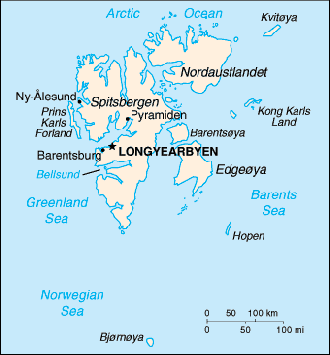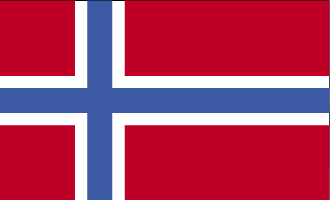
|
Svalbard Island
Background:
First discovered by the Norwegians in the 12th century, the islands served as
an international whaling base during the 17th and 18th centuries. Norway's
sovereignty was recognized in 1920; five years later it officially took over
the territory.
Location:
Location: Northern Europe, islands between the Arctic Ocean, Barents Sea,
Greenland Sea, and Norwegian Sea, north of Norway.
Area: Total: 62,049 sq km; note: includes Spitsbergen and Bjornoya (Bear
Island).
Area - comparative: Slightly smaller than West Virginia.
Coastline: 3,587 km.
Climate and Terrain:
Climate: Arctic, tempered by warm North Atlantic Current; cool summers, cold
winters; North Atlantic Current flows along west and north coasts of
Spitsbergen, keeping water open and navigable most of the year.
Terrain: Wild, rugged mountains; much of high land ice covered; west coast
clear of ice about one-half of the year; fjords along west and north coasts.
Natural resources: Coal, copper, iron ore, phosphate, zinc, wildlife, fish.
Geography - note: Northernmost part of the Kingdom of Norway; consists of nine
main islands; glaciers and snowfields cover 60% of the total area.
People:
Population: 2,811.
Ethnic groups: Norwegian 55.4%, Russian and Ukrainian 44.3%, other 0.3%.
Languages: Russian, Norwegian.
Government:
Territory of Norway; administered by the Polar Department of
the Ministry of Justice.
Capital: Longyearbyen.
Economy overview:
Coal mining is the major economic activity on Svalbard. The treaty of 9
February 1920 gives the 41 signatories equal rights to exploit mineral
deposits, subject to Norwegian regulation. Although US, UK, Dutch, and Swedish
coal companies have mined in the past, the only companies still mining are
Norwegian and Russian. The settlements on Svalbard are essentially company
towns. The Norwegian state-owned coal company employs nearly 60% of the
Norwegian population on the island, runs many of the local services, and
provides most of the local infrastructure. There is also some trapping of seal,
polar bear, fox, and walrus.
Statistics:
Radio broadcast stations: AM 1, FM 1 (plus 2 repeaters).
Railways: 0 km.
Airports: 4.
Return to Visiting Locations
|

